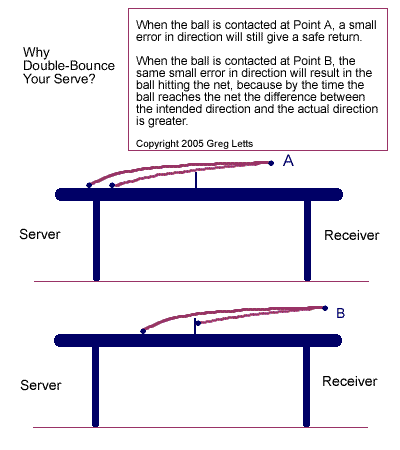The Guide to Serving in Table Tennis
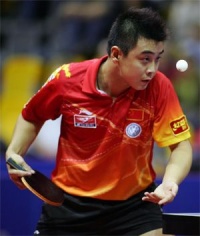
Using your service to win games
First published on Sunday, November 20, 2005
Last updated on Sunday, November 27, 2005
by Greg Letts - an Australian state coach, an International Umpire and one of the top ranked players in his country.
Ask just about any high level player what the most important shot in table tennis is, and the chances are pretty good that he'll reply - the serve.
But on the whole, the serve is a much neglected part of lower level players, who prefer to practice their rallying skills when training, and like to talk about the best technique for a forehand loop. In this series of articles I'm going to redress that balance a little, as I concentrate on that oft-underrated stroke - the serve. After all - every point has one!
I'm going to start in this article by discussing some general aspects that apply to all types of serves. In later articles in the series we will examine particular serves in more detail, such as the Forehand Pendulum serve, the Backhand backspin/sidespin serve, etc.
Now, for those of you who like to know why, away we go...
Why is the Serve important?
What is it about the serve that makes it such an important stroke? Reasons include:
- Control - it is the only stroke that you make where you have total control of the ball, without any interference or influence from the opponent. As such you should be able to do exactly what you want with the ball.
- Frequency - as I mentioned in jest above, every point starts with a serve. And considering that the average rally length at higher levels is often only 3-5 strokes, that means the serve makes up a pretty high proportion of shots played during a match.
- Setup - good use of serves can strongly influence the stroke played by the receiver, allowing a good server to predict the return and play more of his favourite third and fifth ball patterns.
- Pressure - a player who knows his opponent has better serves than he does will feel under pressure right from the start of the rally. Conversely, a player with better serves than his opponent will usually feel a bit more relaxed, knowing that he has an important edge every time he gets the serve.
- Knowledge - the better you are at serving yourself, the more you understand about how certain serves work, and the best ways to identify them and return them.
What makes a good serve?
This is a trickier question to answer, because what could be a good serve under one set of circumstances could be a bad serve under another. So instead of giving a hard and fast definition of a good serve, I'll discuss several of the factors involved in serving, which work together in different amounts to make a serve good or bad depending on the situation.
Double-bounce serve
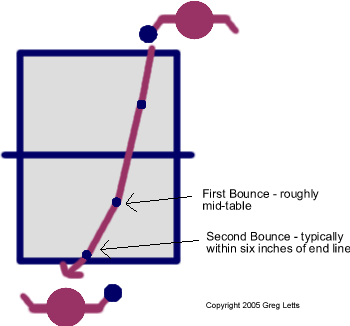 | The concept of frequently using a double-bounce serve (where the ball would bounce twice on the opponent's side if left alone) is one of the most important in serving. Watch videos of the pros and notice just how often they are trying to do this on their own serves. Bear in mind that the second bounce should be somewhere close to within six inches of the end line - shorter serves or more bounces are not better! Reasons for the popularity of this serve include: |
A Typical Double-bounce Serve | |
| |
| |
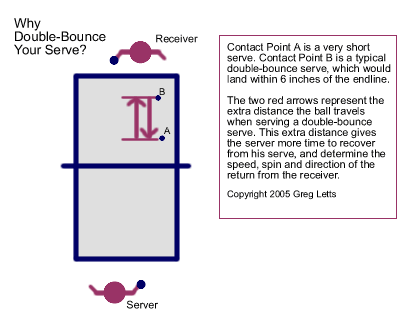 | (a) increasing the time you have to recover from your serve and react to his return; |
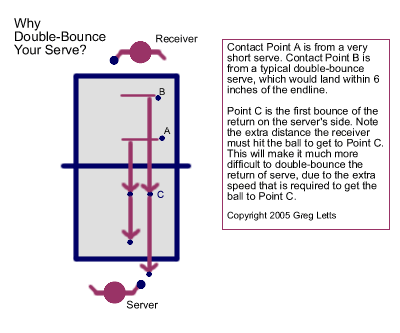 | (b) maximising the distance he has to play the ball to get it over the net, making it more difficult for him to drop the ball short (ie double-bounce the return). This increases your chances of getting a return that goes over your endline, making it easier for you to use your normal attack stroke; |
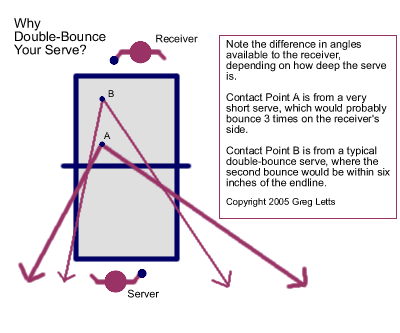 | (c) because it is deep, it cuts down the amount of angle your opponent can use, effectively making your next attack easier; |
| (d) any mistake made by your opponent in reading the spin is magnified by the extra distance the ball has to travel. A mistake that would be insignificant when made from a distance of six inches (15cm) from the net can be a return that goes into the net or high into the air when made from over a metre away (remember, each half of the table tennis table is 1.37m long). |
Long serves
These are serves that bounce once on the opponent's side of the table, typically within six inches or so of his endline. The emphasis is on surprise and speed to force weaker returns from opponents, which can then be counterattacked. If your opponent is not caught off-guard, you may be getting a very strong attack coming back at you, so use with care!
Placement
The placement of the ball when served to the opponent will have an effect on whether the serve is a good or bad one. What makes for good or bad placement will depend largely on your opponent - different players stand in different positions when receiving serves, and also hold their bats differently in preparation for their receive. They will also have different strengths and weaknesses in returning serve (ie some will be better at flicking than pushing, some might be great at looping long balls on the forehand but weaker at long balls on the backhand).
Some things to be aware of in terms of placement are:
-
Don't serve half-long serves (by my definition, these are serves that bounce once around the middle of the opponent's side, and then go over the endline). A good opponent will be looping or driving these back at you, putting you under pressure right from the start.
-
Definitely don't serve half-long serves to the opponent's power zones (where he can hit a forehand or backhand loop or drive without having to move sideways at all). A half-long serve that avoids the power zone at least makes the opponent move and hit, which is tougher to do.
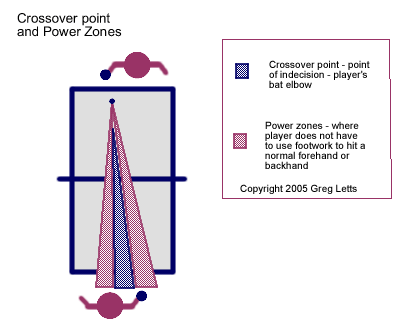
A good option is to cross over or go into the opponent's playing elbow (also called the point of indecision). For shakehanders and reverse penhold backhand (RPB) penholders, this area is where the opponent must make a decision between returning with a forehand or backhand. For standard penholders, the point of indecision is the area where they must decide between a forehand side hit and a backhand side push/block or hit. Crossing over or entering this zone forces the opponent to decide quickly which stroke to use, and then he must also use footwork to allow him to hit the stroke correctly. By forcing him to make more decisions and use footwork too you increase the chances of him making the wrong decision, or making a mistake whilst trying to move and then hit the ball.
Deception
Deception has always been an important part of serving. With the recent rule changes designed to end the practice of hiding the ball during the service, deception in serving has changed as well. Nowadays, players focus on deceiving their opponent by:
-
Type of Spin - players use serves that look similar to each other, but actually have slightly different spin. For example, this can often be a serve that looks like light backspin and sidespin, but actually has only sidespin. An unwary opponent will play the ball expecting backspin, and will return the ball high enough to allow the server to attack.
-
Amount of Spin - the server attempts to deceive the receiver about how much spin is on the ball. For example, the server tries to make the serve look like it is light backspin and sidespin, but in actual fact puts a lot of backspin on the ball. He is hoping that the opponent will treat the serve as a light backspin and put the ball in the net.
-
Placement - a player makes it obvious he is serving in one direction, but at the last split-second he turns his bat a fraction to change the direction the ball is going. This tends to be used more on long, fast serves, where the receiver does not have much time to adjust to the change in direction.
-
Faking - more advanced servers can swing the bat back and forth near the time of contact, making it very difficult to see just when the ball was contacted. This is not an easy technique to master, but it can be very effective.
-
Sidespin - many good players incorporate sidespin into almost every serve. Using sidespin gives the opponent one more thing to worry about, and it also helps to make it harder to tell what amount of backspin or topspin has been put on the ball. Don't forget to use different amounts of sidespin as well!
Follow-up
Use serves that tend to complement your best third-ball and fifth-ball attacks. If you are better at opening your attack from a backspin ball, use double-bounce serves with heavy backspin and sidespin, that are difficult to flick, in order to encourage a push return. If you are better at counterattacking, you would be justified in using more long serves with varied spin and placement, to allow your opponent to attack, but to make it hard for him to attack well, so you can make a strong counterattack on your third ball.
Practice
Considering how important the serve is, how often and for how long you should practice it? I would recommend at least 10 minutes of serve practice for every hour spent training. You have to do enough to keep your serves sharp - there is not a lot of room for error when double-bounce serving or serving long and deep. Also, try to find some time where you can just serve with a bucket of balls and no opponent - when you play against someone else it can often be hard to know whether you really are double-bouncing the serve, or is your opponent pushing or flicking balls that he really should be looping back?
Make a point of having a working knowledge of all the serves - you don't have to master each one straight away but you should know the theory of how to execute them. This will also help you when it comes time for you to return someone elses serves! You will need to master at a minimum the forehand pendulum serve (with backspin/sidespin, sidespin only, and topspin/sidespin) and the standard backhand serve (again with backspin/sidespin, sidespin only, and topspin/sidespin). More exotic serves such as the forehand tomahawk, reverse pendulum and others can be mastered later.
Serving - other factors to consider
Some other aspects of serving to keep in mind include:
-
Height of the ball toss -
-
a higher ball toss translates into more speed on the ball when it makes contact with your racket during the serve. This can generate more spin and speed, but also can be harder to control and keep to a double-bounce length.
-
most players seem to have a standard height that they like to throw the ball up to. Try to avoid allowing the opponent to know what serve you are using from the height of the serve. For example, when you use a forehand pendulum serve, try to use the same throw height for all varieties (backspin-sidespin, sidespin, and topspin-sidespin). Avoid using the high-toss to only serve long serves, since your opponent will know what to expect as soon as you throw the ball high.
-
- Variety - your serves will be more effective if you can use a well-blended mixture of them to keep your opponent on his toes. Don't overuse your best serves and let your opponent get comfortable with them.
-
Keep an eye on your opponent - an opponent that is continually standing very close to the endline may be an ideal candidate for a fast long serve out wide to the forehand, or straight into his playing elbow. Conversely, an opponent who is standing deep might be caught by a very short triple-bounce serve - a good example of when it may be the right idea to break the general rules of serving.
-
Scout your opponent before the match to see which serves he is better or worse at returning, and make sure you use this information wisely.
-
'Goto' serves - some players like to have a special serve kept back just for big points that they really need to win. Other players like to use all their best serves in order to try to stay well in front of the opponent. Both points of view have merit - try them both and see which suits you better.
-
Double-bounce vs long serves - don't overdo the long serves. As your standard of opponent improves you will need to use them less, unless you have some really impressive long serves or you are a terrific counterattacker. There is no hard and fast ratio of double-bounce to long serves, but in my own personal opinion any more than a 3 to 1 ratio is probably too many long serves.
-
Watch the height of the bounce - be careful not to allow the ball to bounce too high over the net - this will make the second bounce high as well and allow a good opponent to actually loop a serve that would have double bounced. Low bounces over the net are the way to go - usually done by contacting the ball at service not much higher than net height.
-
Forehand vs Backhand serves - it is worthwhile to develop a strong backhand serve in order to provide even more variety when serving, and to be able to serve to your opponent from a different angle with different spins.
-
Positioning during the service - most of the time I would recommend serving your forehand pendulum serves from the backhand corner, and your backhand serves from the middle of the table. This provides a lot of variety of service angles and spins. But from time to time, feel free to try out a forehand pendulum from the middle of the table or a backhand serve from either the forehand or backhand corner - you might just expose an unexpected weakness in your opponent by doing so!
-
Grip during the service - some players like to hold the racket only with the thumb and forefinger, removing the other three fingers. This gives them more freedom of movement, but does force them to regrip before playing their third ball. Other players don't bother. Try it both ways and see which way you prefer. And remember, you can still do it both ways if you like!
-
Test out most of your range of serves early on during the match- you want to confirm what is effective and what doesn't work so well. Stay alert to what is working or not working during the match, and adjust your serve tactics accordingly.
Serving - Conclusion
The points mentioned above should be enough to get you started when you are ready to look at improving your service execution and tactics. In future articles we'll look at the different individual serves one at a time.
© 2005-2025 Greg Letts
You may also read Greg's blog and purchase Australian TT videos from Greg's own website


